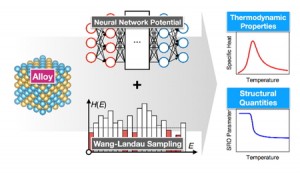[Published online Journal of Computer Chemistry, Japan Vol.21, 111-117, by J-STAGE]
<Title:> On the Thermodynamic Stability of Alloys: Combination of Neural Network Potential and Wang-Landau Sampling
<Author(s):> Tien Quang NGUYEN, Yusuke NANBA, Michihisa KOYAMA
<Corresponding author E-Mill:> quang(at)shinshu-u.ac.jp
<Abstract:> Thermodynamic properties and atomic configuration of PdRu alloy were investigated using Wang-Landau Monte Carlo method in combination with a newly-developed universal neural network potential. By using this new potential, excess energy of PdRu alloy was calculated. It is found that PdRu alloy in FCC lattice is unstable in the full range of alloy composition. This agrees with previous study based on density functional theory. The combined method was able to determine the configurational density of states, from which thermodynamic properties of the alloy were derived. It is found that when temperature increases, the excess free energy of the alloy is reduced, increasing the possibility of alloy mixing. Depending on the composition, transition peaks appear at finite temperatures where there are changes of preferable atomic arrangement due to the effect of temperature via the configurational entropy. In addition, the analyses on short-range order parameter and bond fraction show that PdRu alloy prefers to be in segregated form, where Pd and Ru are immiscible at low temperature, consistent with the experimental observations. The random mixing of Pd and Ru atoms in the form of solid-solution can occur at high temperature.
<Keywords:> Alloy stability, Wang-Landau sampling, Neural network potential, Short-range order parameter, Bond fraction
<URL:> https://www.jstage.jst.go.jp/article/jccj/21/4/21_2023-0015/_article/-char/ja/
<Title:> On the Thermodynamic Stability of Alloys: Combination of Neural Network Potential and Wang-Landau Sampling
<Author(s):> Tien Quang NGUYEN, Yusuke NANBA, Michihisa KOYAMA
<Corresponding author E-Mill:> quang(at)shinshu-u.ac.jp
<Abstract:> Thermodynamic properties and atomic configuration of PdRu alloy were investigated using Wang-Landau Monte Carlo method in combination with a newly-developed universal neural network potential. By using this new potential, excess energy of PdRu alloy was calculated. It is found that PdRu alloy in FCC lattice is unstable in the full range of alloy composition. This agrees with previous study based on density functional theory. The combined method was able to determine the configurational density of states, from which thermodynamic properties of the alloy were derived. It is found that when temperature increases, the excess free energy of the alloy is reduced, increasing the possibility of alloy mixing. Depending on the composition, transition peaks appear at finite temperatures where there are changes of preferable atomic arrangement due to the effect of temperature via the configurational entropy. In addition, the analyses on short-range order parameter and bond fraction show that PdRu alloy prefers to be in segregated form, where Pd and Ru are immiscible at low temperature, consistent with the experimental observations. The random mixing of Pd and Ru atoms in the form of solid-solution can occur at high temperature.
<Keywords:> Alloy stability, Wang-Landau sampling, Neural network potential, Short-range order parameter, Bond fraction
<URL:> https://www.jstage.jst.go.jp/article/jccj/21/4/21_2023-0015/_article/-char/ja/
